System Analysis and Design Report for Allsports Club
VerifiedAdded on 2023/03/17
|16
|1881
|33
Report
AI Summary
This report details the system analysis and design for the Allsports Club, aiming to automate its working processes. It begins with an introduction outlining project objectives, which include designing an information system for editor selection and article management, and identifying associated probl...
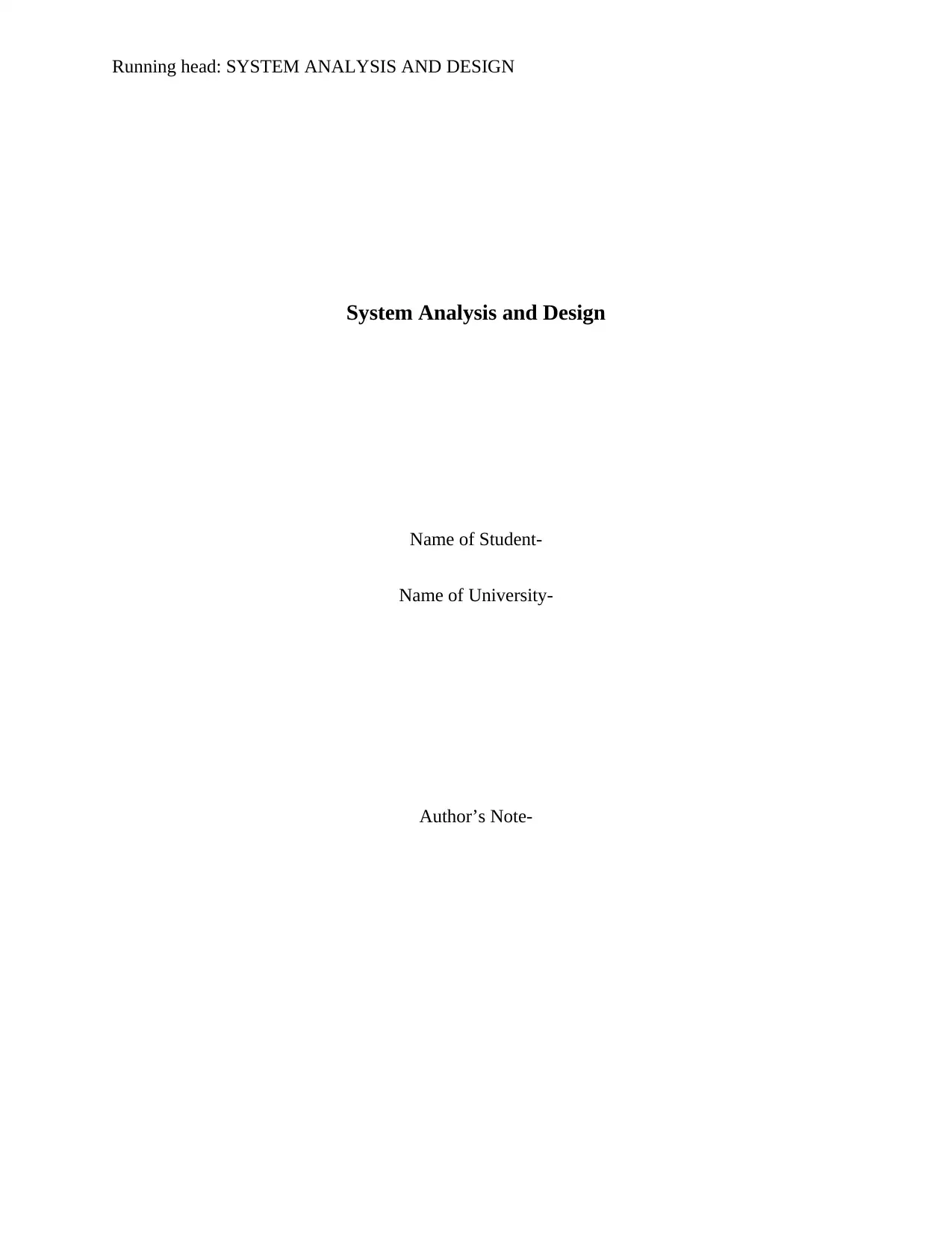
Running head: SYSTEM ANALYSIS AND DESIGN
System Analysis and Design
Name of Student-
Name of University-
Author’s Note-
System Analysis and Design
Name of Student-
Name of University-
Author’s Note-
Paraphrase This Document
Need a fresh take? Get an instant paraphrase of this document with our AI Paraphraser
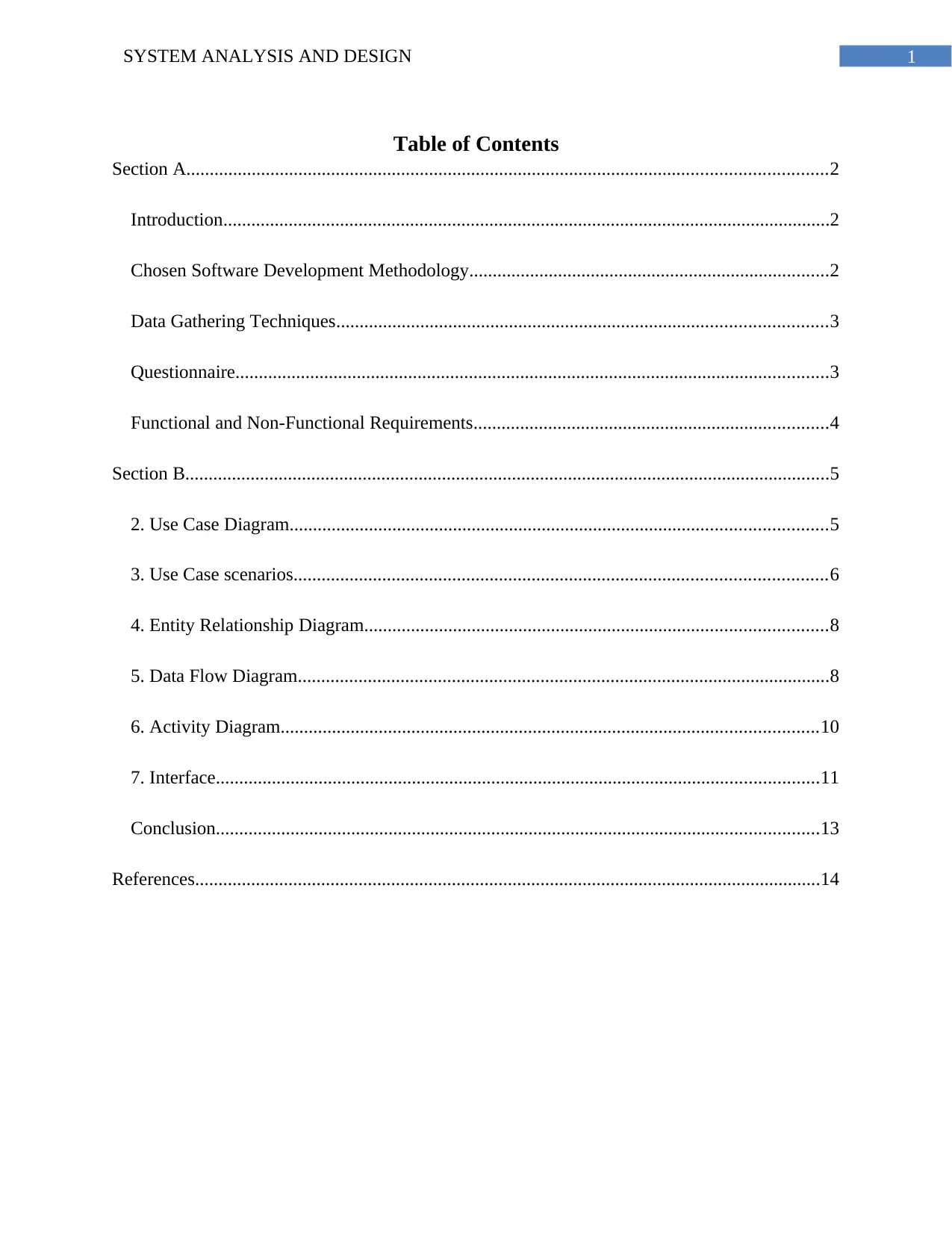
1SYSTEM ANALYSIS AND DESIGN
Table of Contents
Section A.........................................................................................................................................2
Introduction..................................................................................................................................2
Chosen Software Development Methodology.............................................................................2
Data Gathering Techniques.........................................................................................................3
Questionnaire...............................................................................................................................3
Functional and Non-Functional Requirements............................................................................4
Section B..........................................................................................................................................5
2. Use Case Diagram...................................................................................................................5
3. Use Case scenarios..................................................................................................................6
4. Entity Relationship Diagram...................................................................................................8
5. Data Flow Diagram..................................................................................................................8
6. Activity Diagram...................................................................................................................10
7. Interface.................................................................................................................................11
Conclusion.................................................................................................................................13
References......................................................................................................................................14
Table of Contents
Section A.........................................................................................................................................2
Introduction..................................................................................................................................2
Chosen Software Development Methodology.............................................................................2
Data Gathering Techniques.........................................................................................................3
Questionnaire...............................................................................................................................3
Functional and Non-Functional Requirements............................................................................4
Section B..........................................................................................................................................5
2. Use Case Diagram...................................................................................................................5
3. Use Case scenarios..................................................................................................................6
4. Entity Relationship Diagram...................................................................................................8
5. Data Flow Diagram..................................................................................................................8
6. Activity Diagram...................................................................................................................10
7. Interface.................................................................................................................................11
Conclusion.................................................................................................................................13
References......................................................................................................................................14
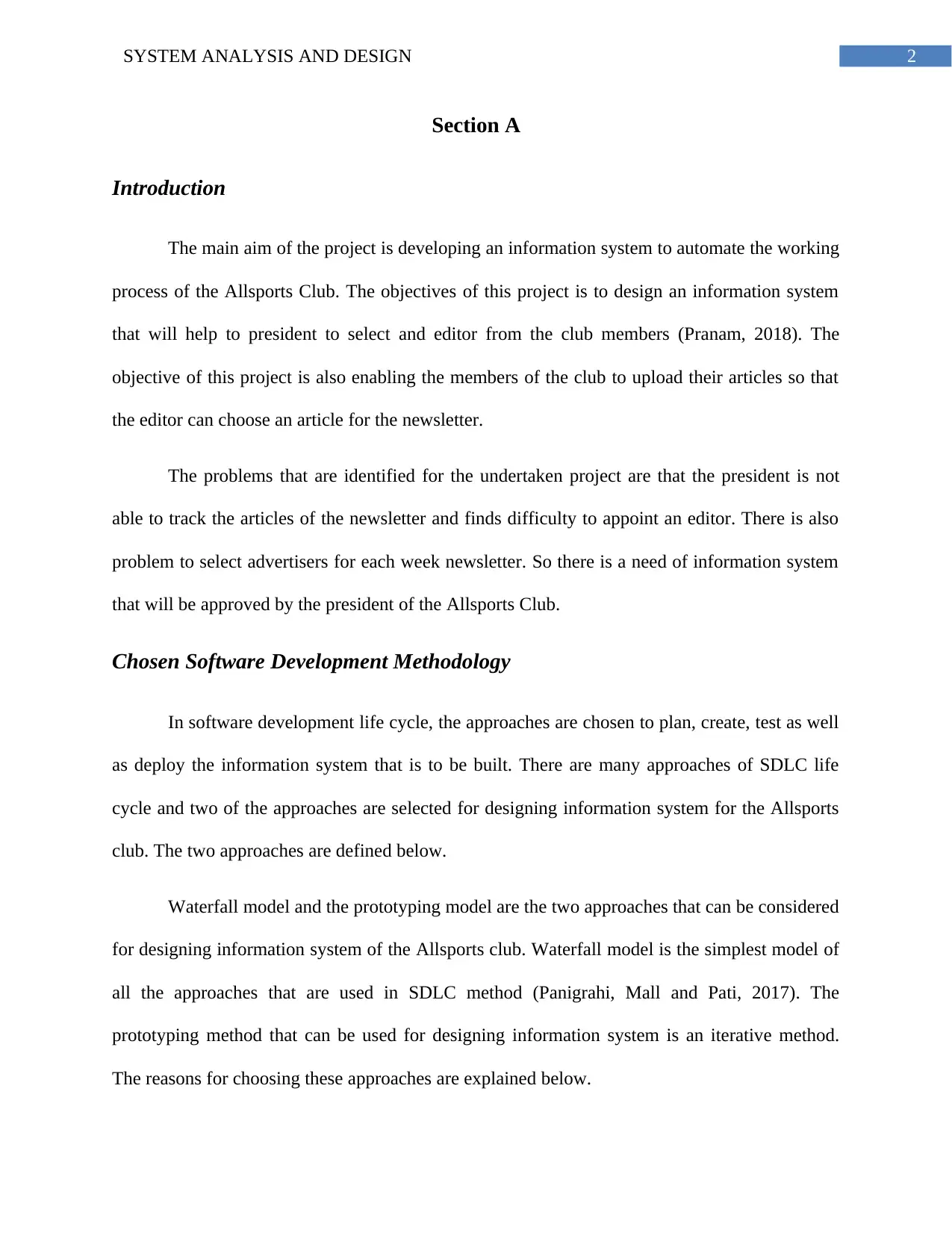
2SYSTEM ANALYSIS AND DESIGN
Section A
Introduction
The main aim of the project is developing an information system to automate the working
process of the Allsports Club. The objectives of this project is to design an information system
that will help to president to select and editor from the club members (Pranam, 2018). The
objective of this project is also enabling the members of the club to upload their articles so that
the editor can choose an article for the newsletter.
The problems that are identified for the undertaken project are that the president is not
able to track the articles of the newsletter and finds difficulty to appoint an editor. There is also
problem to select advertisers for each week newsletter. So there is a need of information system
that will be approved by the president of the Allsports Club.
Chosen Software Development Methodology
In software development life cycle, the approaches are chosen to plan, create, test as well
as deploy the information system that is to be built. There are many approaches of SDLC life
cycle and two of the approaches are selected for designing information system for the Allsports
club. The two approaches are defined below.
Waterfall model and the prototyping model are the two approaches that can be considered
for designing information system of the Allsports club. Waterfall model is the simplest model of
all the approaches that are used in SDLC method (Panigrahi, Mall and Pati, 2017). The
prototyping method that can be used for designing information system is an iterative method.
The reasons for choosing these approaches are explained below.
Section A
Introduction
The main aim of the project is developing an information system to automate the working
process of the Allsports Club. The objectives of this project is to design an information system
that will help to president to select and editor from the club members (Pranam, 2018). The
objective of this project is also enabling the members of the club to upload their articles so that
the editor can choose an article for the newsletter.
The problems that are identified for the undertaken project are that the president is not
able to track the articles of the newsletter and finds difficulty to appoint an editor. There is also
problem to select advertisers for each week newsletter. So there is a need of information system
that will be approved by the president of the Allsports Club.
Chosen Software Development Methodology
In software development life cycle, the approaches are chosen to plan, create, test as well
as deploy the information system that is to be built. There are many approaches of SDLC life
cycle and two of the approaches are selected for designing information system for the Allsports
club. The two approaches are defined below.
Waterfall model and the prototyping model are the two approaches that can be considered
for designing information system of the Allsports club. Waterfall model is the simplest model of
all the approaches that are used in SDLC method (Panigrahi, Mall and Pati, 2017). The
prototyping method that can be used for designing information system is an iterative method.
The reasons for choosing these approaches are explained below.
⊘ This is a preview!⊘
Do you want full access?
Subscribe today to unlock all pages.

Trusted by 1+ million students worldwide
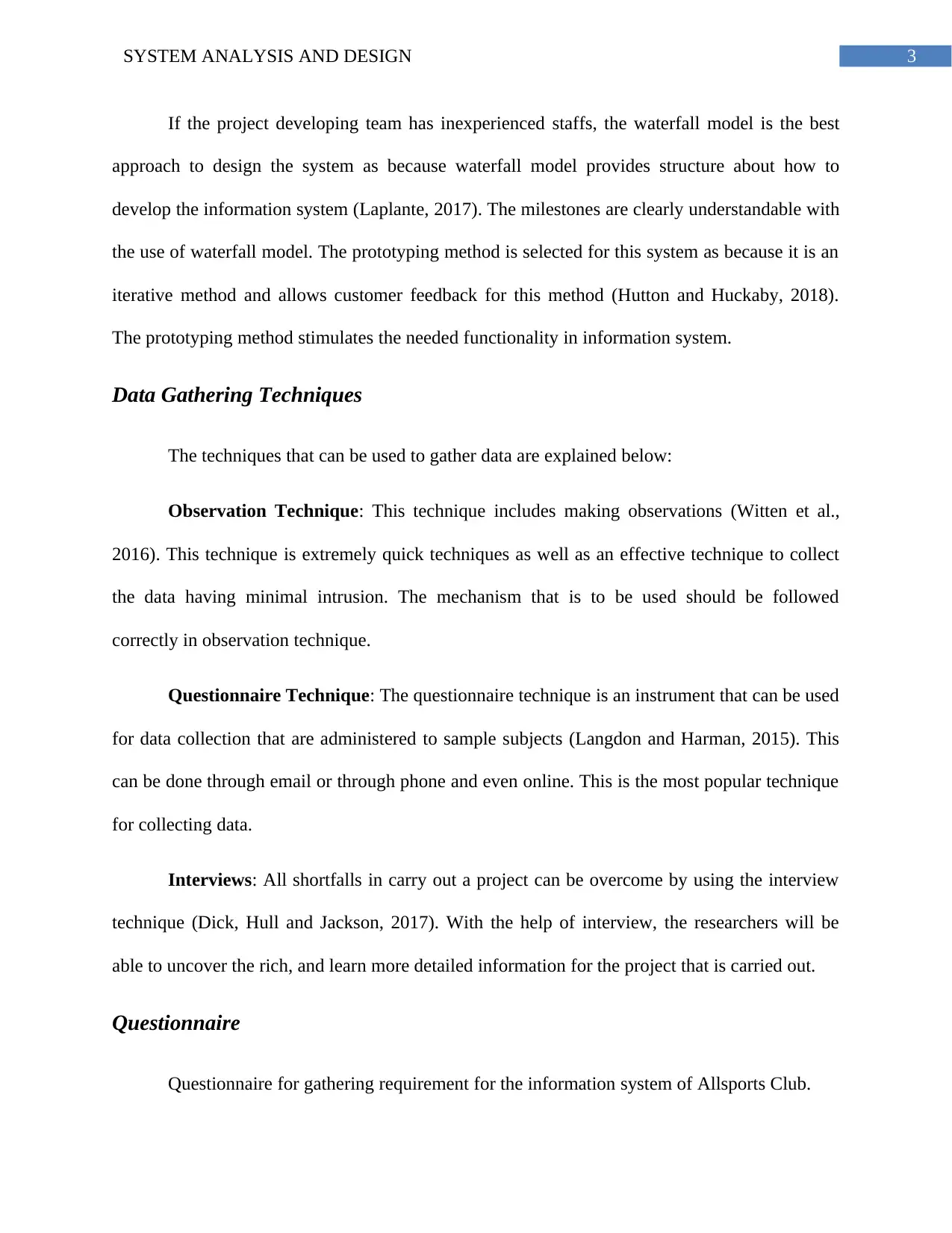
3SYSTEM ANALYSIS AND DESIGN
If the project developing team has inexperienced staffs, the waterfall model is the best
approach to design the system as because waterfall model provides structure about how to
develop the information system (Laplante, 2017). The milestones are clearly understandable with
the use of waterfall model. The prototyping method is selected for this system as because it is an
iterative method and allows customer feedback for this method (Hutton and Huckaby, 2018).
The prototyping method stimulates the needed functionality in information system.
Data Gathering Techniques
The techniques that can be used to gather data are explained below:
Observation Technique: This technique includes making observations (Witten et al.,
2016). This technique is extremely quick techniques as well as an effective technique to collect
the data having minimal intrusion. The mechanism that is to be used should be followed
correctly in observation technique.
Questionnaire Technique: The questionnaire technique is an instrument that can be used
for data collection that are administered to sample subjects (Langdon and Harman, 2015). This
can be done through email or through phone and even online. This is the most popular technique
for collecting data.
Interviews: All shortfalls in carry out a project can be overcome by using the interview
technique (Dick, Hull and Jackson, 2017). With the help of interview, the researchers will be
able to uncover the rich, and learn more detailed information for the project that is carried out.
Questionnaire
Questionnaire for gathering requirement for the information system of Allsports Club.
If the project developing team has inexperienced staffs, the waterfall model is the best
approach to design the system as because waterfall model provides structure about how to
develop the information system (Laplante, 2017). The milestones are clearly understandable with
the use of waterfall model. The prototyping method is selected for this system as because it is an
iterative method and allows customer feedback for this method (Hutton and Huckaby, 2018).
The prototyping method stimulates the needed functionality in information system.
Data Gathering Techniques
The techniques that can be used to gather data are explained below:
Observation Technique: This technique includes making observations (Witten et al.,
2016). This technique is extremely quick techniques as well as an effective technique to collect
the data having minimal intrusion. The mechanism that is to be used should be followed
correctly in observation technique.
Questionnaire Technique: The questionnaire technique is an instrument that can be used
for data collection that are administered to sample subjects (Langdon and Harman, 2015). This
can be done through email or through phone and even online. This is the most popular technique
for collecting data.
Interviews: All shortfalls in carry out a project can be overcome by using the interview
technique (Dick, Hull and Jackson, 2017). With the help of interview, the researchers will be
able to uncover the rich, and learn more detailed information for the project that is carried out.
Questionnaire
Questionnaire for gathering requirement for the information system of Allsports Club.
Paraphrase This Document
Need a fresh take? Get an instant paraphrase of this document with our AI Paraphraser
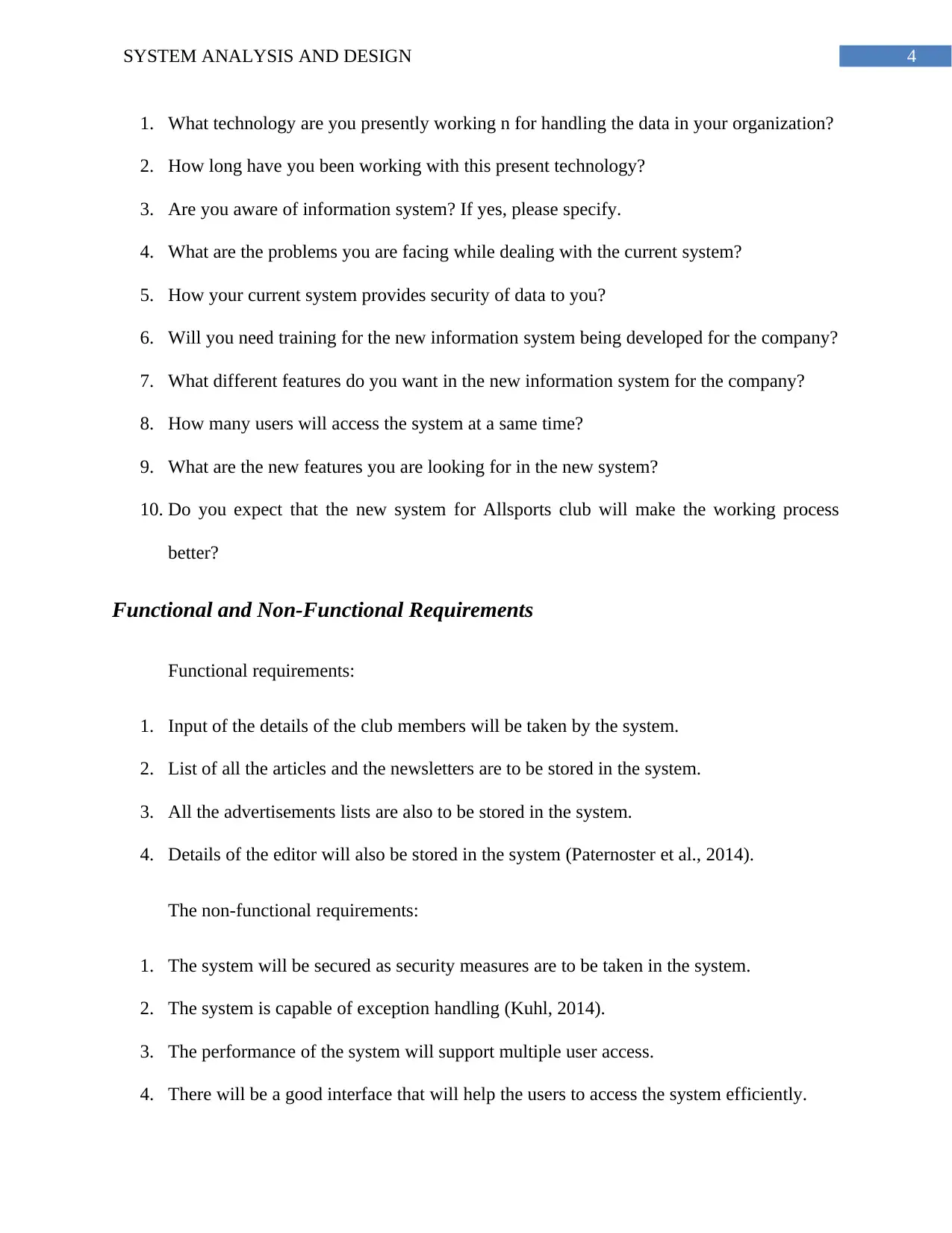
4SYSTEM ANALYSIS AND DESIGN
1. What technology are you presently working n for handling the data in your organization?
2. How long have you been working with this present technology?
3. Are you aware of information system? If yes, please specify.
4. What are the problems you are facing while dealing with the current system?
5. How your current system provides security of data to you?
6. Will you need training for the new information system being developed for the company?
7. What different features do you want in the new information system for the company?
8. How many users will access the system at a same time?
9. What are the new features you are looking for in the new system?
10. Do you expect that the new system for Allsports club will make the working process
better?
Functional and Non-Functional Requirements
Functional requirements:
1. Input of the details of the club members will be taken by the system.
2. List of all the articles and the newsletters are to be stored in the system.
3. All the advertisements lists are also to be stored in the system.
4. Details of the editor will also be stored in the system (Paternoster et al., 2014).
The non-functional requirements:
1. The system will be secured as security measures are to be taken in the system.
2. The system is capable of exception handling (Kuhl, 2014).
3. The performance of the system will support multiple user access.
4. There will be a good interface that will help the users to access the system efficiently.
1. What technology are you presently working n for handling the data in your organization?
2. How long have you been working with this present technology?
3. Are you aware of information system? If yes, please specify.
4. What are the problems you are facing while dealing with the current system?
5. How your current system provides security of data to you?
6. Will you need training for the new information system being developed for the company?
7. What different features do you want in the new information system for the company?
8. How many users will access the system at a same time?
9. What are the new features you are looking for in the new system?
10. Do you expect that the new system for Allsports club will make the working process
better?
Functional and Non-Functional Requirements
Functional requirements:
1. Input of the details of the club members will be taken by the system.
2. List of all the articles and the newsletters are to be stored in the system.
3. All the advertisements lists are also to be stored in the system.
4. Details of the editor will also be stored in the system (Paternoster et al., 2014).
The non-functional requirements:
1. The system will be secured as security measures are to be taken in the system.
2. The system is capable of exception handling (Kuhl, 2014).
3. The performance of the system will support multiple user access.
4. There will be a good interface that will help the users to access the system efficiently.
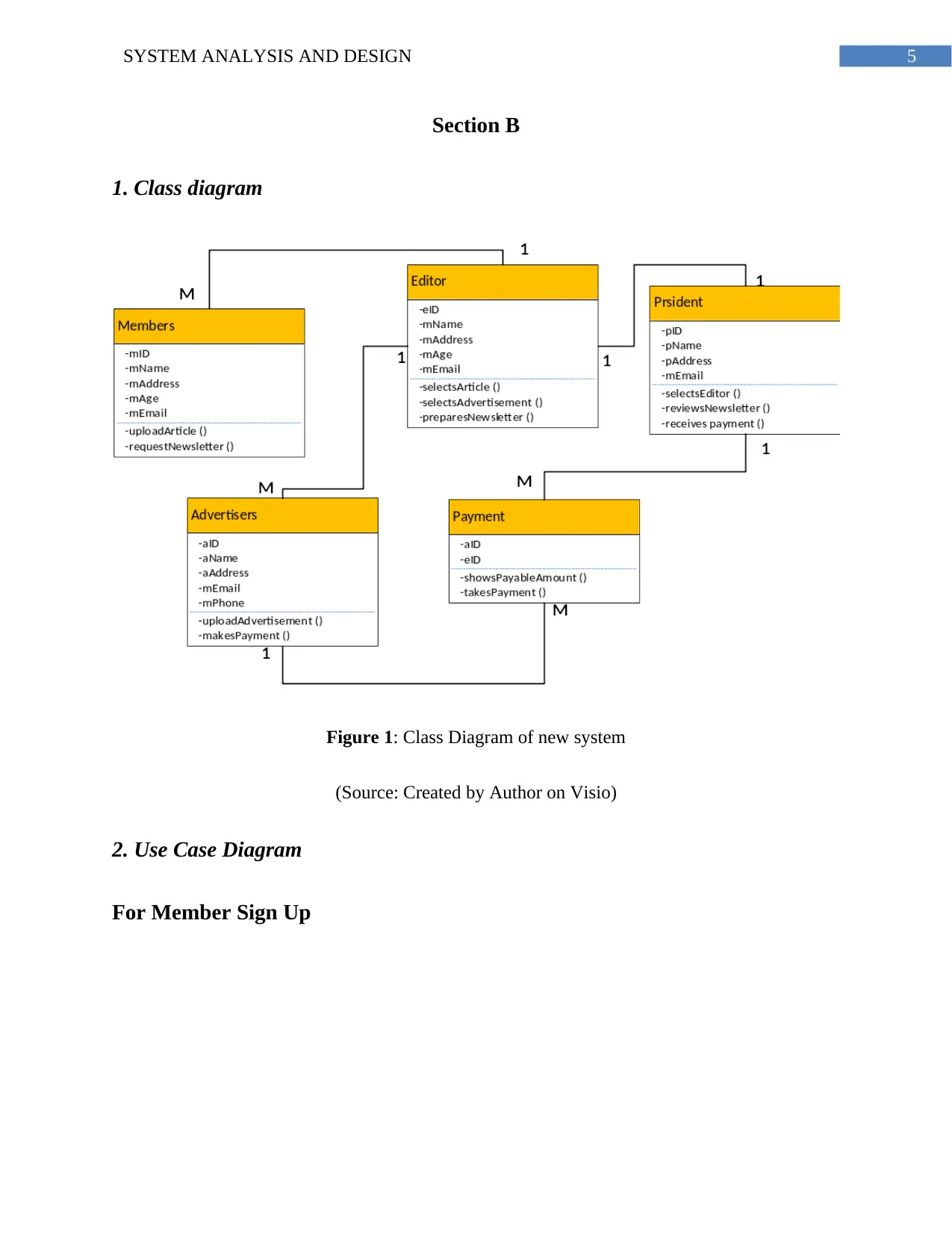
5SYSTEM ANALYSIS AND DESIGN
Section B
1. Class diagram
Figure 1: Class Diagram of new system
(Source: Created by Author on Visio)
2. Use Case Diagram
For Member Sign Up
Section B
1. Class diagram
Figure 1: Class Diagram of new system
(Source: Created by Author on Visio)
2. Use Case Diagram
For Member Sign Up
⊘ This is a preview!⊘
Do you want full access?
Subscribe today to unlock all pages.

Trusted by 1+ million students worldwide
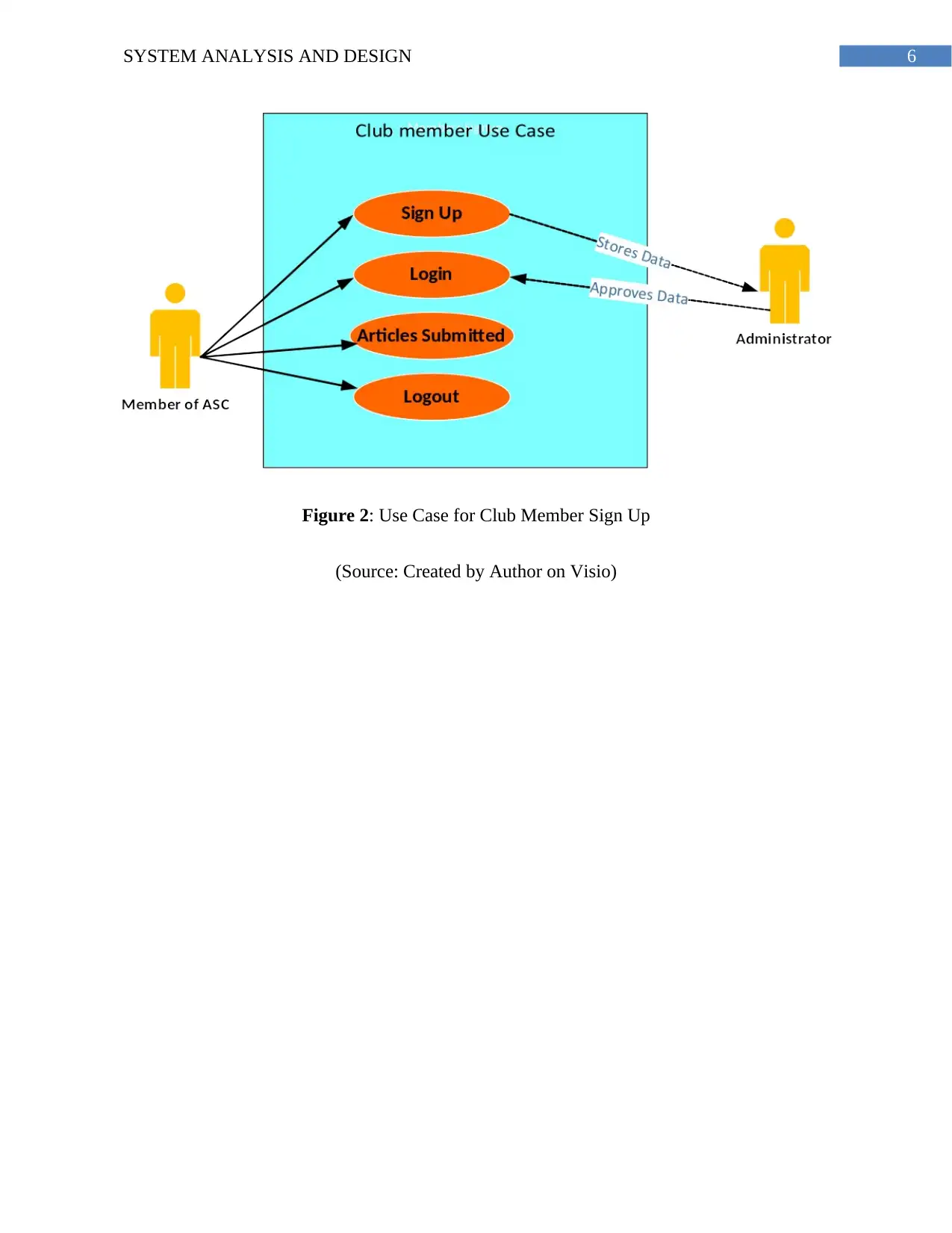
6SYSTEM ANALYSIS AND DESIGN
Figure 2: Use Case for Club Member Sign Up
(Source: Created by Author on Visio)
Figure 2: Use Case for Club Member Sign Up
(Source: Created by Author on Visio)
Paraphrase This Document
Need a fresh take? Get an instant paraphrase of this document with our AI Paraphraser
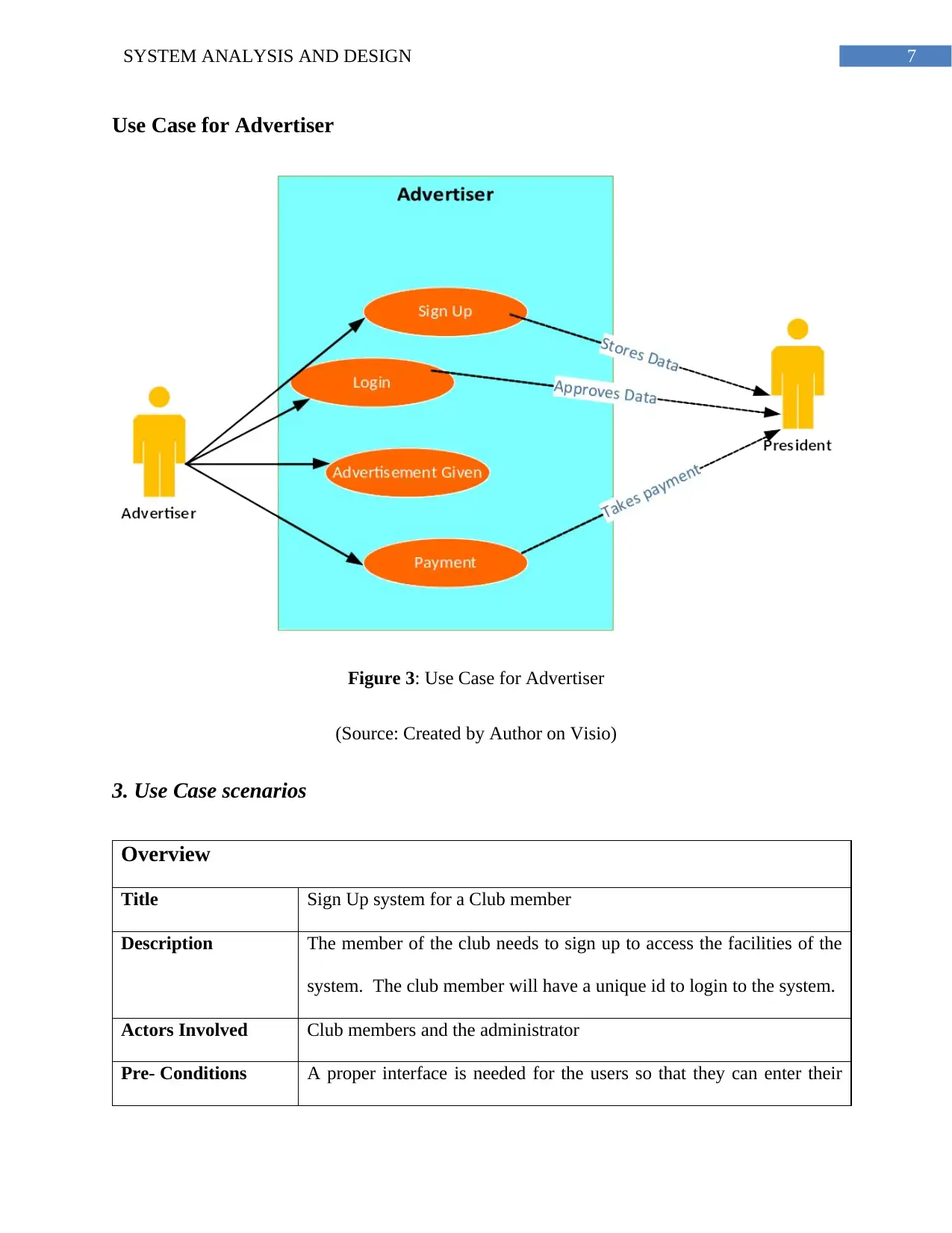
7SYSTEM ANALYSIS AND DESIGN
Use Case for Advertiser
Figure 3: Use Case for Advertiser
(Source: Created by Author on Visio)
3. Use Case scenarios
Overview
Title Sign Up system for a Club member
Description The member of the club needs to sign up to access the facilities of the
system. The club member will have a unique id to login to the system.
Actors Involved Club members and the administrator
Pre- Conditions A proper interface is needed for the users so that they can enter their
Use Case for Advertiser
Figure 3: Use Case for Advertiser
(Source: Created by Author on Visio)
3. Use Case scenarios
Overview
Title Sign Up system for a Club member
Description The member of the club needs to sign up to access the facilities of the
system. The club member will have a unique id to login to the system.
Actors Involved Club members and the administrator
Pre- Conditions A proper interface is needed for the users so that they can enter their
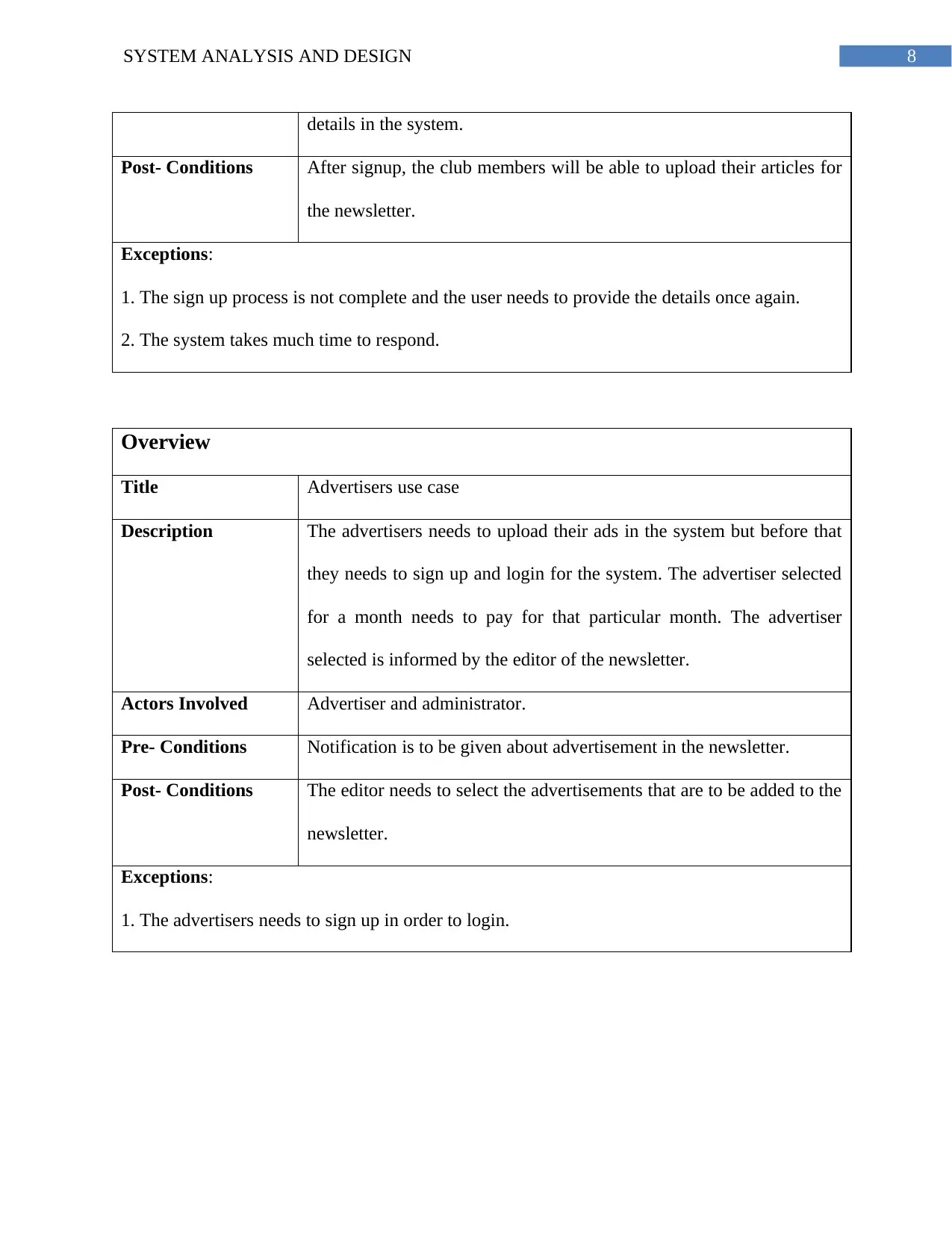
8SYSTEM ANALYSIS AND DESIGN
details in the system.
Post- Conditions After signup, the club members will be able to upload their articles for
the newsletter.
Exceptions:
1. The sign up process is not complete and the user needs to provide the details once again.
2. The system takes much time to respond.
Overview
Title Advertisers use case
Description The advertisers needs to upload their ads in the system but before that
they needs to sign up and login for the system. The advertiser selected
for a month needs to pay for that particular month. The advertiser
selected is informed by the editor of the newsletter.
Actors Involved Advertiser and administrator.
Pre- Conditions Notification is to be given about advertisement in the newsletter.
Post- Conditions The editor needs to select the advertisements that are to be added to the
newsletter.
Exceptions:
1. The advertisers needs to sign up in order to login.
details in the system.
Post- Conditions After signup, the club members will be able to upload their articles for
the newsletter.
Exceptions:
1. The sign up process is not complete and the user needs to provide the details once again.
2. The system takes much time to respond.
Overview
Title Advertisers use case
Description The advertisers needs to upload their ads in the system but before that
they needs to sign up and login for the system. The advertiser selected
for a month needs to pay for that particular month. The advertiser
selected is informed by the editor of the newsletter.
Actors Involved Advertiser and administrator.
Pre- Conditions Notification is to be given about advertisement in the newsletter.
Post- Conditions The editor needs to select the advertisements that are to be added to the
newsletter.
Exceptions:
1. The advertisers needs to sign up in order to login.
⊘ This is a preview!⊘
Do you want full access?
Subscribe today to unlock all pages.

Trusted by 1+ million students worldwide
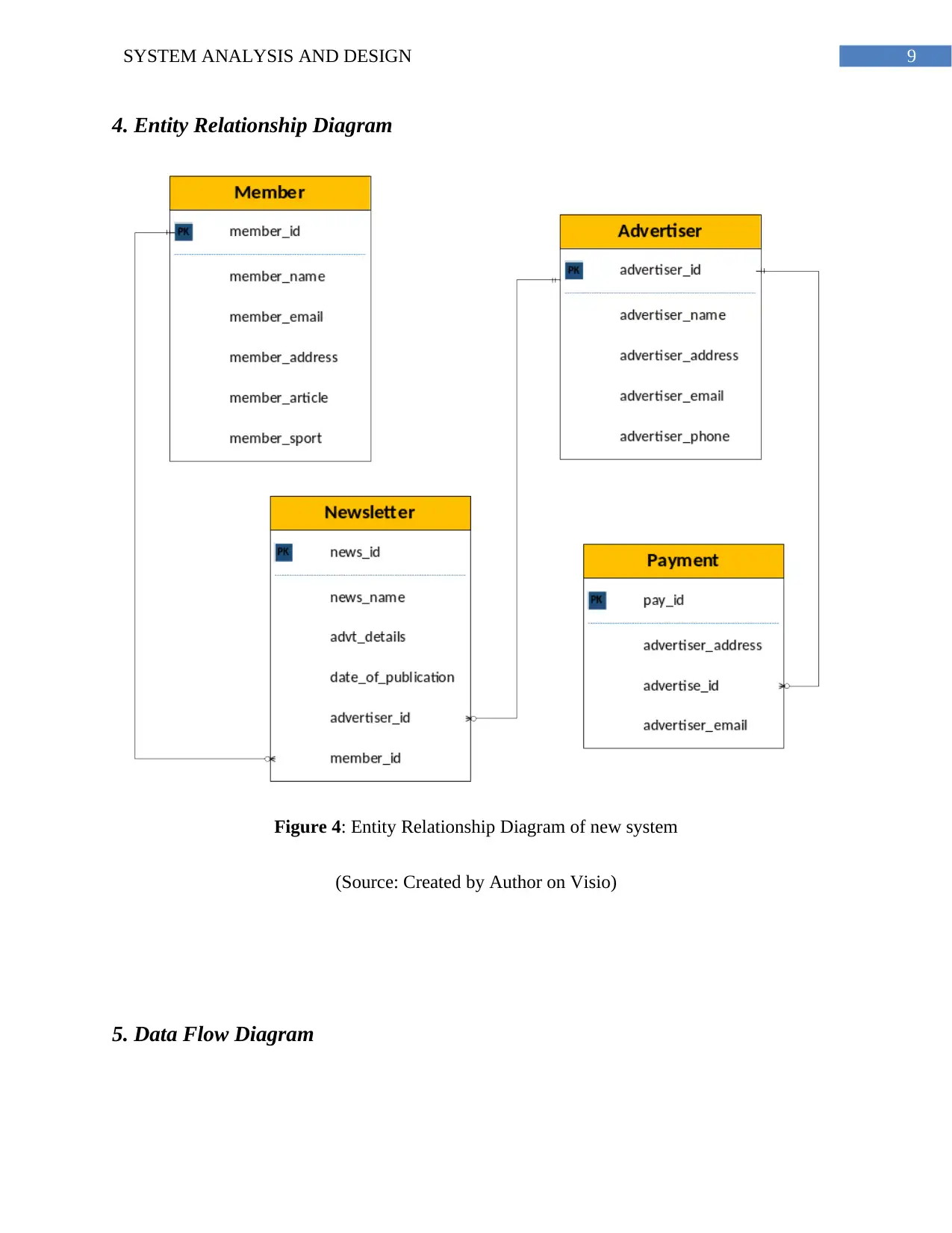
9SYSTEM ANALYSIS AND DESIGN
4. Entity Relationship Diagram
Figure 4: Entity Relationship Diagram of new system
(Source: Created by Author on Visio)
5. Data Flow Diagram
4. Entity Relationship Diagram
Figure 4: Entity Relationship Diagram of new system
(Source: Created by Author on Visio)
5. Data Flow Diagram
Paraphrase This Document
Need a fresh take? Get an instant paraphrase of this document with our AI Paraphraser
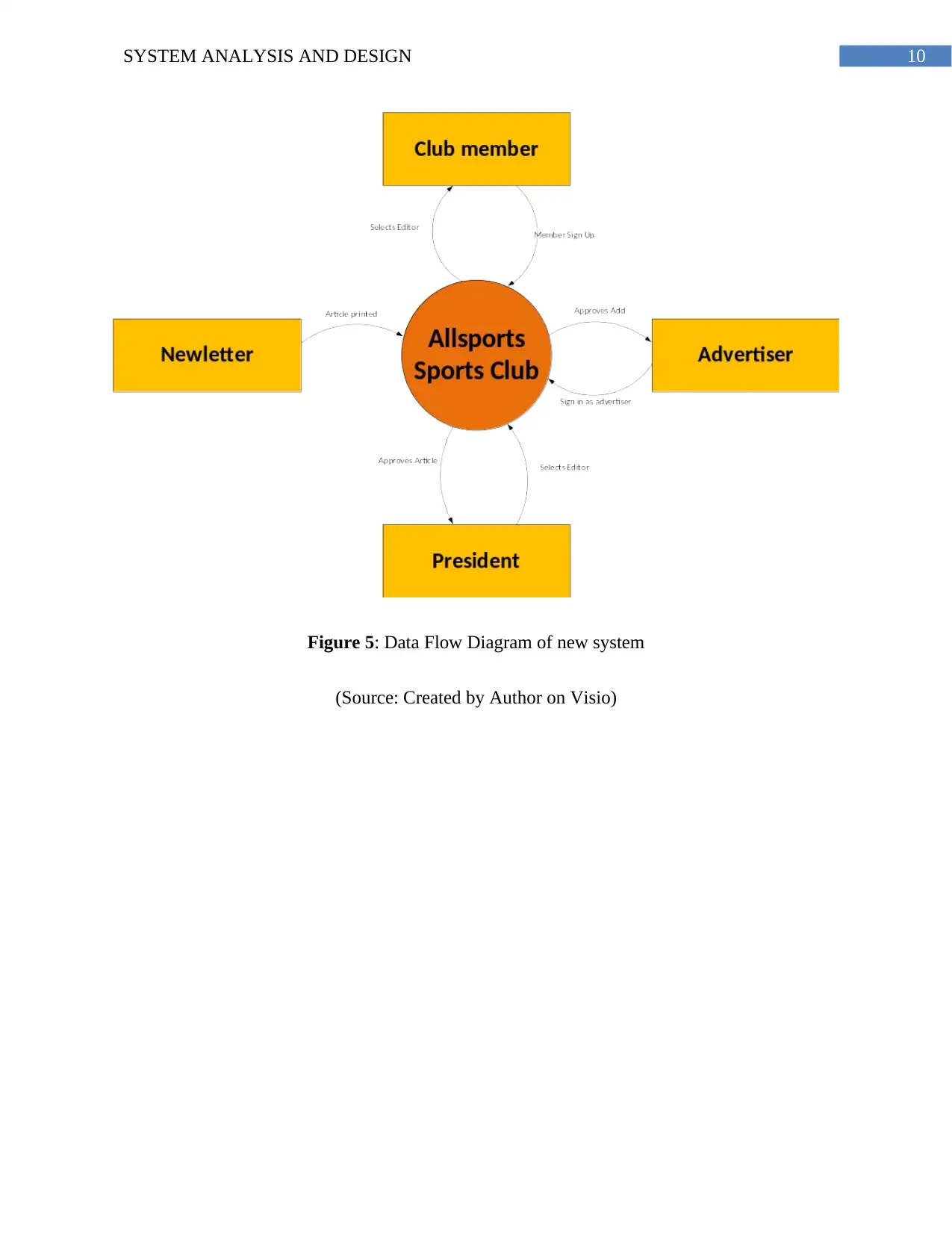
10SYSTEM ANALYSIS AND DESIGN
Figure 5: Data Flow Diagram of new system
(Source: Created by Author on Visio)
Figure 5: Data Flow Diagram of new system
(Source: Created by Author on Visio)
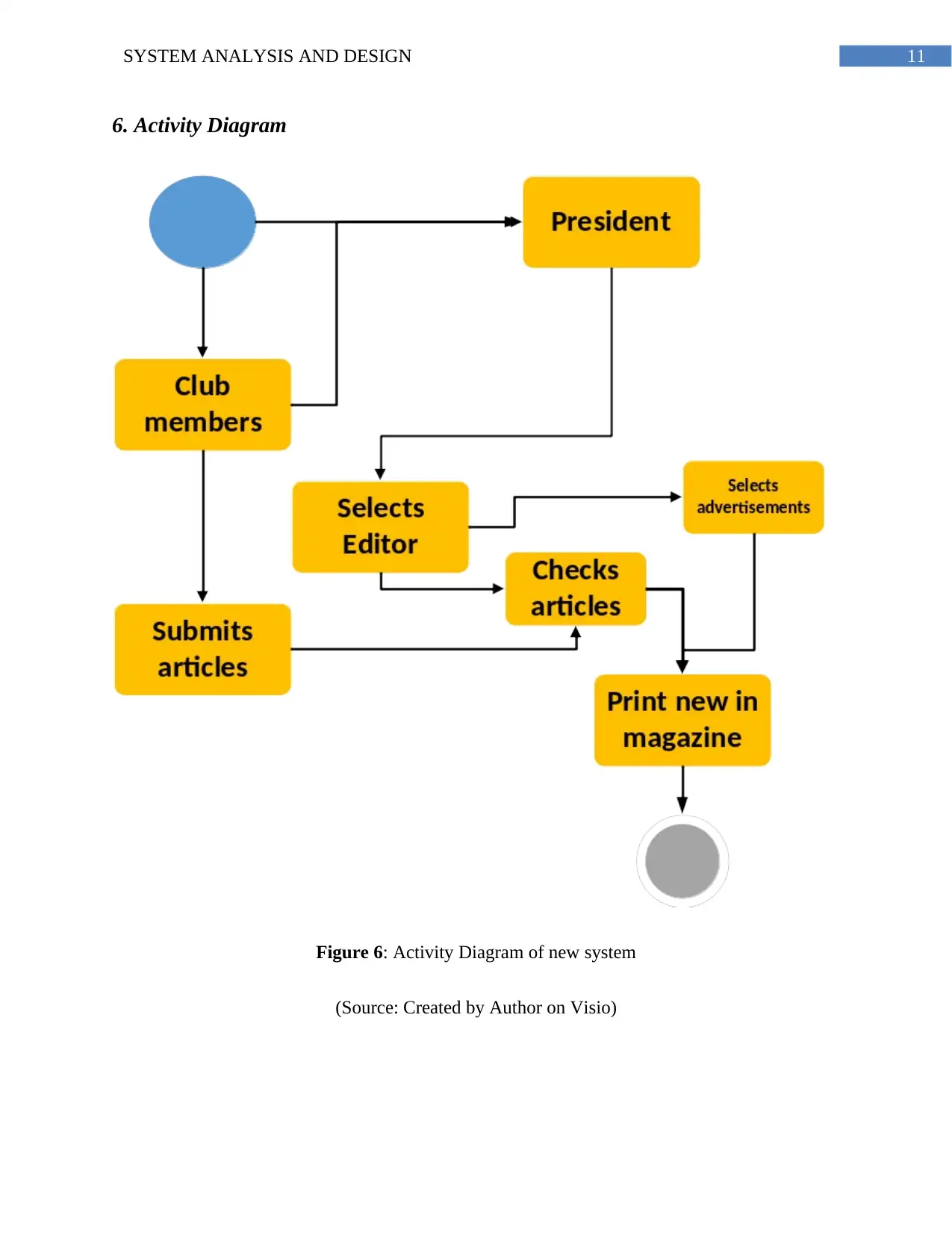
11SYSTEM ANALYSIS AND DESIGN
6. Activity Diagram
Figure 6: Activity Diagram of new system
(Source: Created by Author on Visio)
6. Activity Diagram
Figure 6: Activity Diagram of new system
(Source: Created by Author on Visio)
⊘ This is a preview!⊘
Do you want full access?
Subscribe today to unlock all pages.

Trusted by 1+ million students worldwide
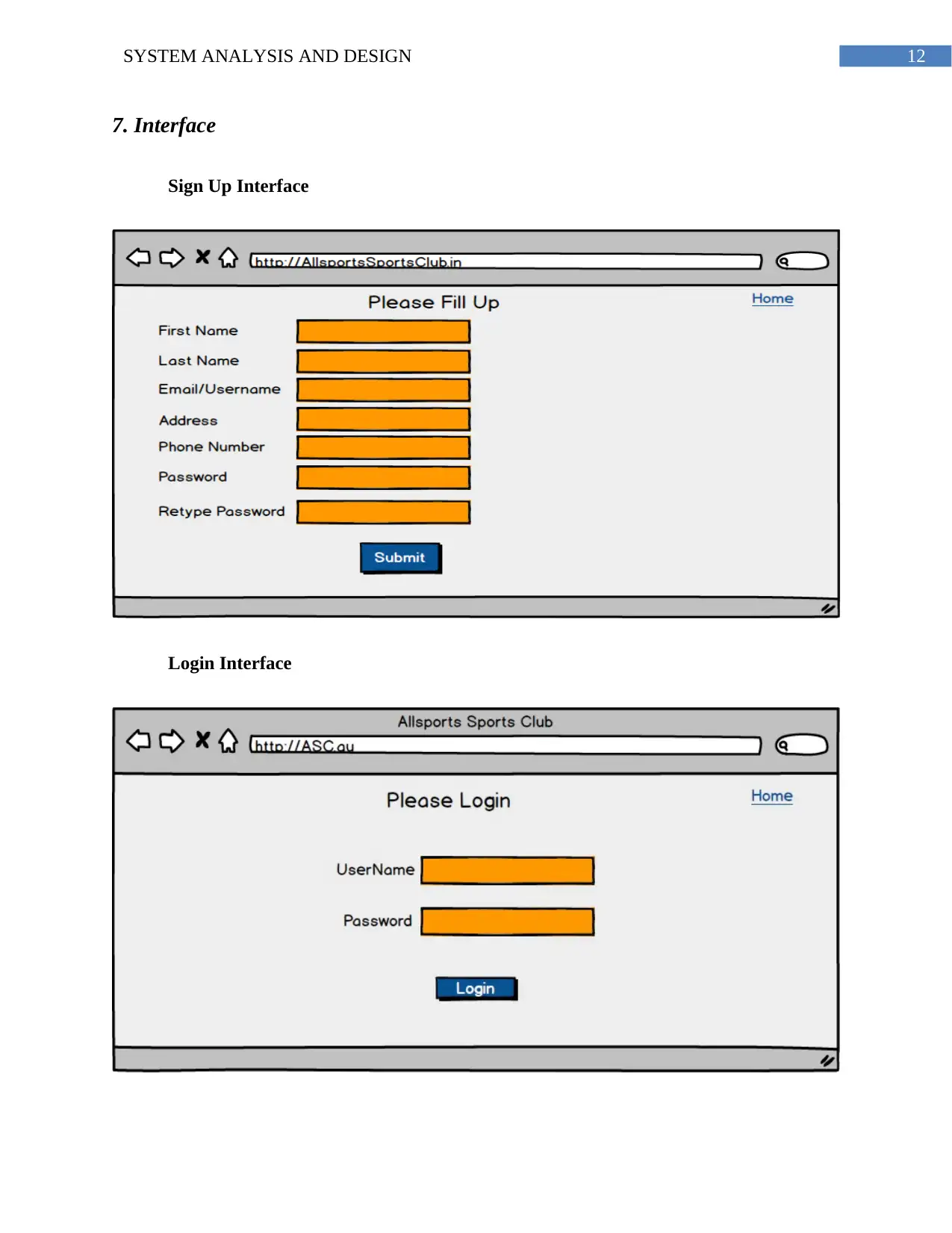
12SYSTEM ANALYSIS AND DESIGN
7. Interface
Sign Up Interface
Login Interface
7. Interface
Sign Up Interface
Login Interface
Paraphrase This Document
Need a fresh take? Get an instant paraphrase of this document with our AI Paraphraser
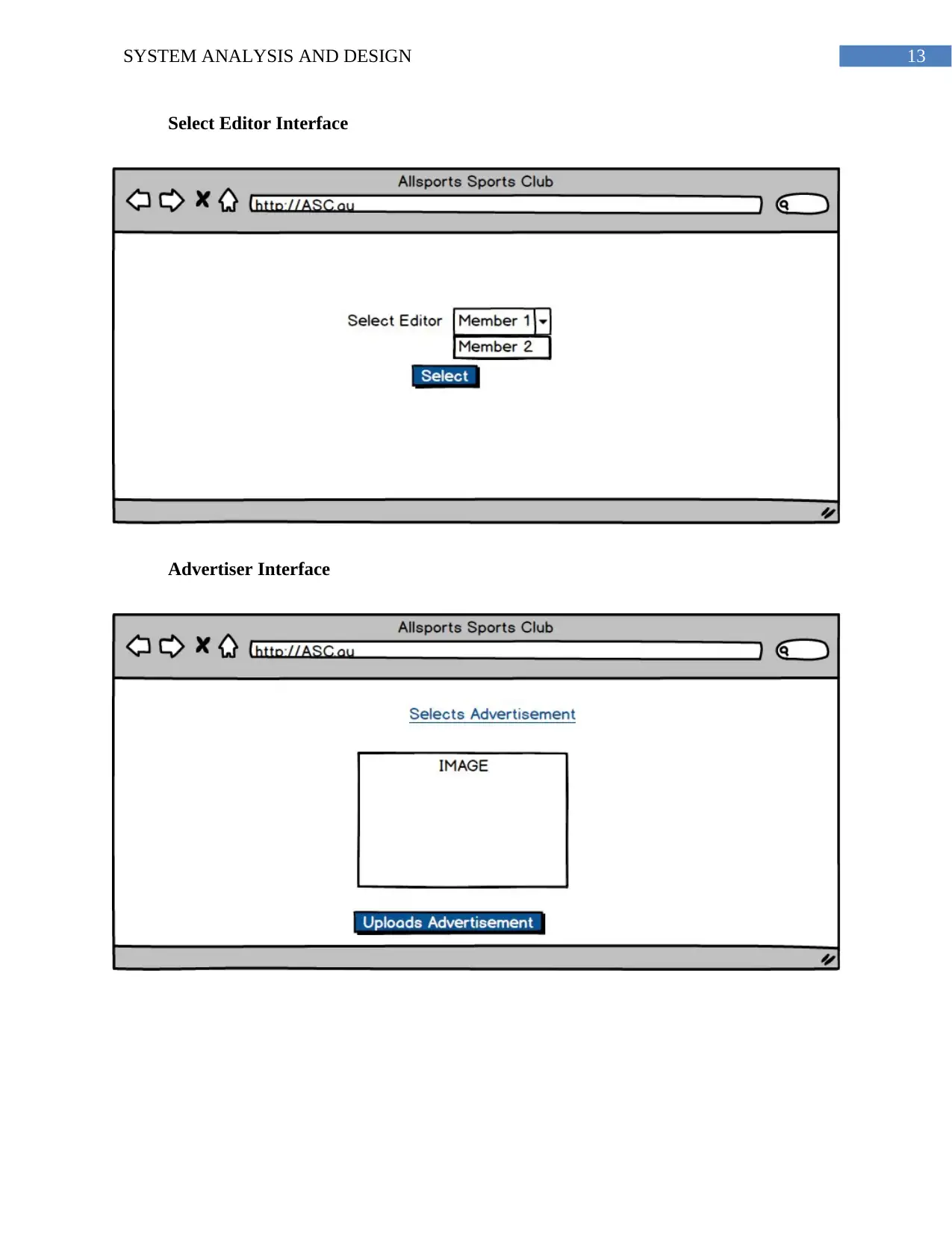
13SYSTEM ANALYSIS AND DESIGN
Select Editor Interface
Advertiser Interface
Select Editor Interface
Advertiser Interface
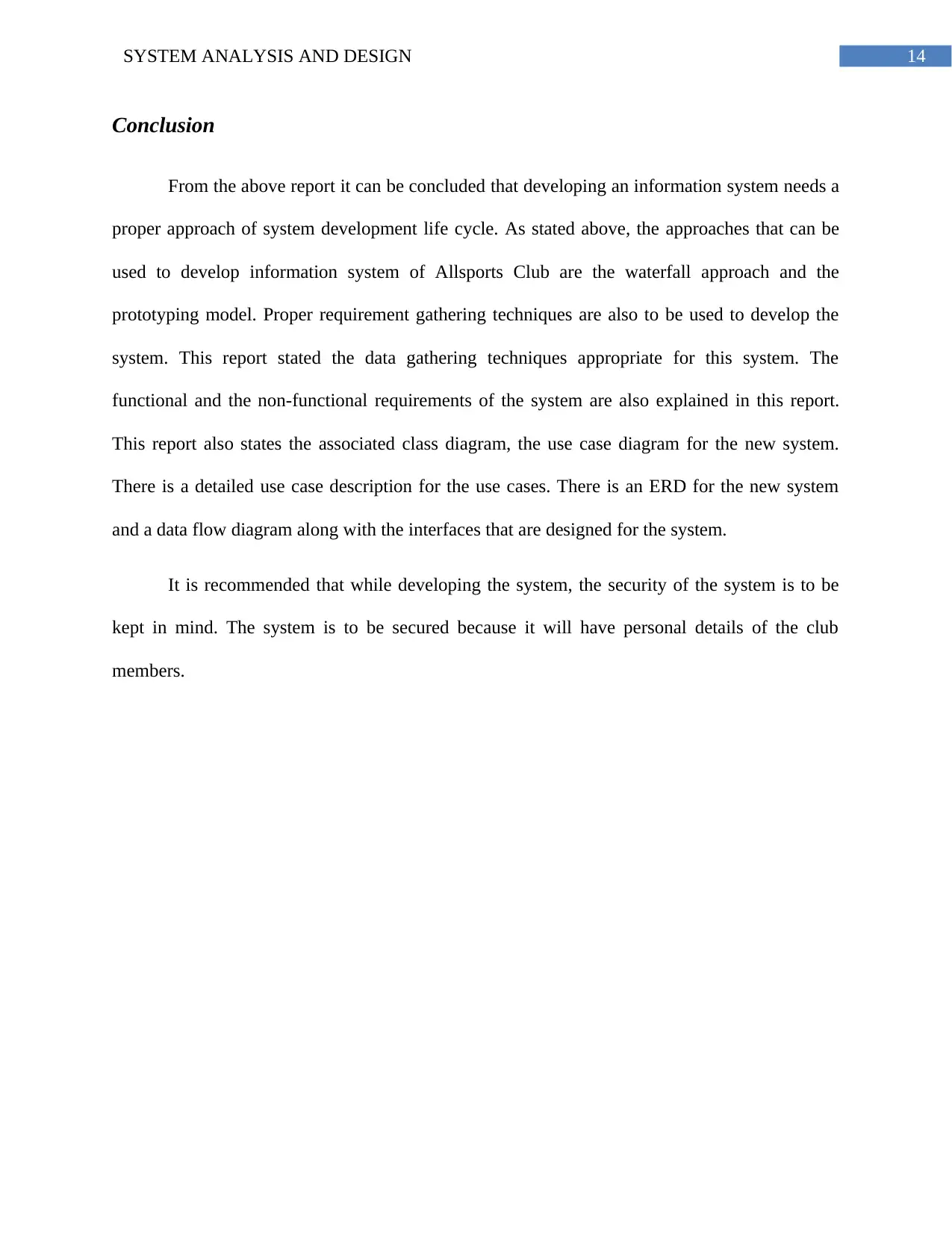
14SYSTEM ANALYSIS AND DESIGN
Conclusion
From the above report it can be concluded that developing an information system needs a
proper approach of system development life cycle. As stated above, the approaches that can be
used to develop information system of Allsports Club are the waterfall approach and the
prototyping model. Proper requirement gathering techniques are also to be used to develop the
system. This report stated the data gathering techniques appropriate for this system. The
functional and the non-functional requirements of the system are also explained in this report.
This report also states the associated class diagram, the use case diagram for the new system.
There is a detailed use case description for the use cases. There is an ERD for the new system
and a data flow diagram along with the interfaces that are designed for the system.
It is recommended that while developing the system, the security of the system is to be
kept in mind. The system is to be secured because it will have personal details of the club
members.
Conclusion
From the above report it can be concluded that developing an information system needs a
proper approach of system development life cycle. As stated above, the approaches that can be
used to develop information system of Allsports Club are the waterfall approach and the
prototyping model. Proper requirement gathering techniques are also to be used to develop the
system. This report stated the data gathering techniques appropriate for this system. The
functional and the non-functional requirements of the system are also explained in this report.
This report also states the associated class diagram, the use case diagram for the new system.
There is a detailed use case description for the use cases. There is an ERD for the new system
and a data flow diagram along with the interfaces that are designed for the system.
It is recommended that while developing the system, the security of the system is to be
kept in mind. The system is to be secured because it will have personal details of the club
members.
⊘ This is a preview!⊘
Do you want full access?
Subscribe today to unlock all pages.

Trusted by 1+ million students worldwide
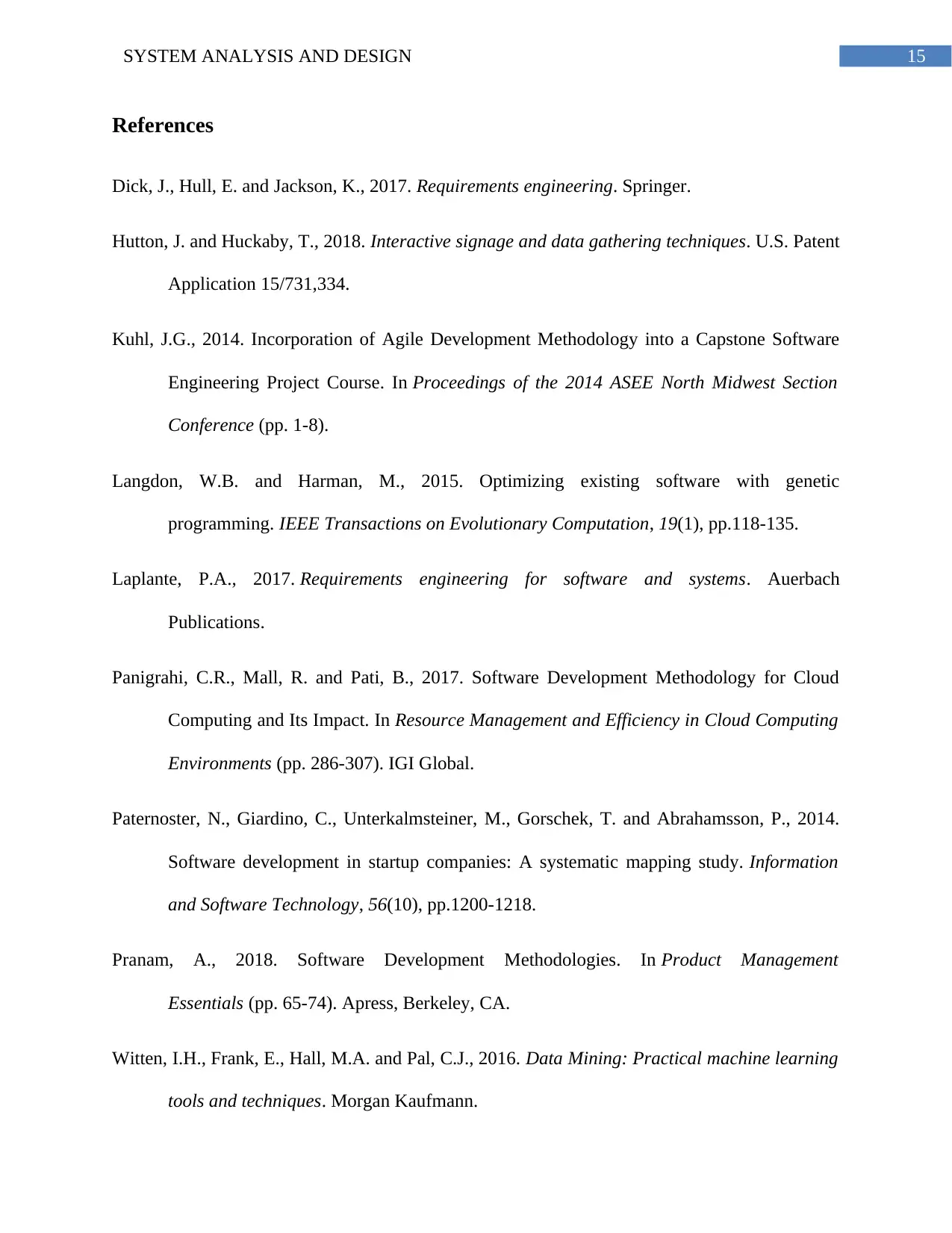
15SYSTEM ANALYSIS AND DESIGN
References
Dick, J., Hull, E. and Jackson, K., 2017. Requirements engineering. Springer.
Hutton, J. and Huckaby, T., 2018. Interactive signage and data gathering techniques. U.S. Patent
Application 15/731,334.
Kuhl, J.G., 2014. Incorporation of Agile Development Methodology into a Capstone Software
Engineering Project Course. In Proceedings of the 2014 ASEE North Midwest Section
Conference (pp. 1-8).
Langdon, W.B. and Harman, M., 2015. Optimizing existing software with genetic
programming. IEEE Transactions on Evolutionary Computation, 19(1), pp.118-135.
Laplante, P.A., 2017. Requirements engineering for software and systems. Auerbach
Publications.
Panigrahi, C.R., Mall, R. and Pati, B., 2017. Software Development Methodology for Cloud
Computing and Its Impact. In Resource Management and Efficiency in Cloud Computing
Environments (pp. 286-307). IGI Global.
Paternoster, N., Giardino, C., Unterkalmsteiner, M., Gorschek, T. and Abrahamsson, P., 2014.
Software development in startup companies: A systematic mapping study. Information
and Software Technology, 56(10), pp.1200-1218.
Pranam, A., 2018. Software Development Methodologies. In Product Management
Essentials (pp. 65-74). Apress, Berkeley, CA.
Witten, I.H., Frank, E., Hall, M.A. and Pal, C.J., 2016. Data Mining: Practical machine learning
tools and techniques. Morgan Kaufmann.
References
Dick, J., Hull, E. and Jackson, K., 2017. Requirements engineering. Springer.
Hutton, J. and Huckaby, T., 2018. Interactive signage and data gathering techniques. U.S. Patent
Application 15/731,334.
Kuhl, J.G., 2014. Incorporation of Agile Development Methodology into a Capstone Software
Engineering Project Course. In Proceedings of the 2014 ASEE North Midwest Section
Conference (pp. 1-8).
Langdon, W.B. and Harman, M., 2015. Optimizing existing software with genetic
programming. IEEE Transactions on Evolutionary Computation, 19(1), pp.118-135.
Laplante, P.A., 2017. Requirements engineering for software and systems. Auerbach
Publications.
Panigrahi, C.R., Mall, R. and Pati, B., 2017. Software Development Methodology for Cloud
Computing and Its Impact. In Resource Management and Efficiency in Cloud Computing
Environments (pp. 286-307). IGI Global.
Paternoster, N., Giardino, C., Unterkalmsteiner, M., Gorschek, T. and Abrahamsson, P., 2014.
Software development in startup companies: A systematic mapping study. Information
and Software Technology, 56(10), pp.1200-1218.
Pranam, A., 2018. Software Development Methodologies. In Product Management
Essentials (pp. 65-74). Apress, Berkeley, CA.
Witten, I.H., Frank, E., Hall, M.A. and Pal, C.J., 2016. Data Mining: Practical machine learning
tools and techniques. Morgan Kaufmann.
1 out of 16
Related Documents
Your All-in-One AI-Powered Toolkit for Academic Success.
+13062052269
info@desklib.com
Available 24*7 on WhatsApp / Email
![[object Object]](/_next/static/media/star-bottom.7253800d.svg)
Unlock your academic potential
© 2024 | Zucol Services PVT LTD | All rights reserved.




